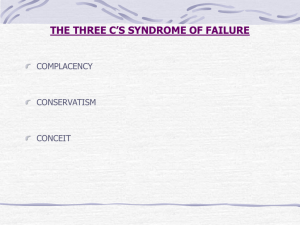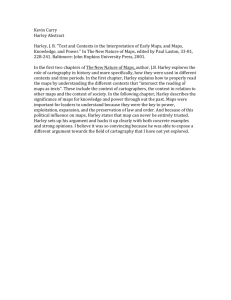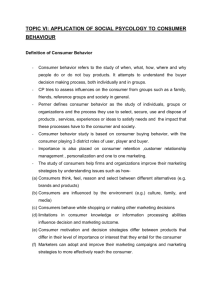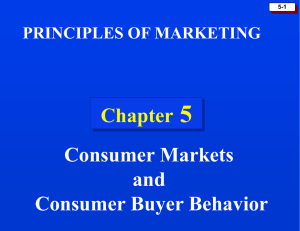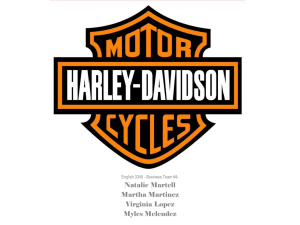- Chap 5.1 Answers
advertisement
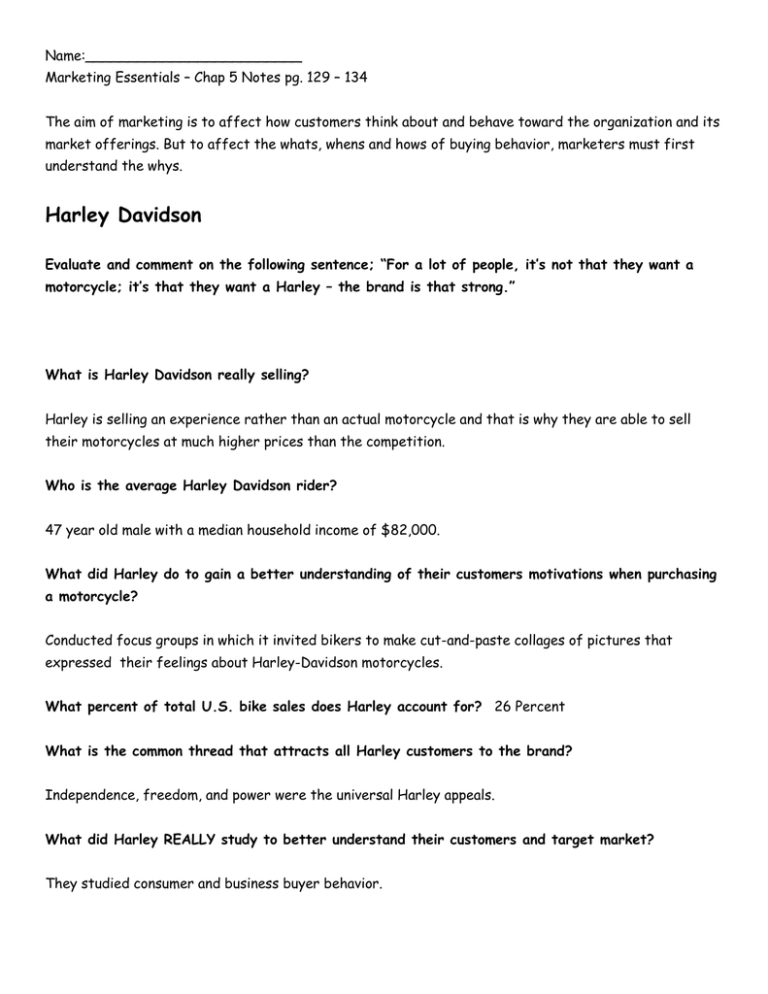
Name:_________________________ Marketing Essentials – Chap 5 Notes pg. 129 – 134 The aim of marketing is to affect how customers think about and behave toward the organization and its market offerings. But to affect the whats, whens and hows of buying behavior, marketers must first understand the whys. Harley Davidson Evaluate and comment on the following sentence; “For a lot of people, it’s not that they want a motorcycle; it’s that they want a Harley – the brand is that strong.” What is Harley Davidson really selling? Harley is selling an experience rather than an actual motorcycle and that is why they are able to sell their motorcycles at much higher prices than the competition. Who is the average Harley Davidson rider? 47 year old male with a median household income of $82,000. What did Harley do to gain a better understanding of their customers motivations when purchasing a motorcycle? Conducted focus groups in which it invited bikers to make cut-and-paste collages of pictures that expressed their feelings about Harley-Davidson motorcycles. What percent of total U.S. bike sales does Harley account for? 26 Percent What is the common thread that attracts all Harley customers to the brand? Independence, freedom, and power were the universal Harley appeals. What did Harley REALLY study to better understand their customers and target market? They studied consumer and business buyer behavior. Consumer Markets and Consumer Buying Behavior Consumer Buying Behavior: Refers The buying behavior of final consumers, individuals and households who buy goods and services for personal consumption. Consumer Market: All the individuals and households who buyor acquire goods and services for personal consumption Describe the American consumer market? Consists of more than 300 million people who consumer more than $12 trillion worth of goods and services. Describe the world consumer market? Consists of more than 6.6 billion people who annually consume an estimated $65 trillion worth of goods and services. Model of Consumer Behavior Businesses spend billions of dollars analyzing and studying what consumers buy, where and how much. But learning about the whys of consumer buying behavior is not so easy-the answers are often locked deep within the consumer’s mind. What is the central question for marketers? How do consumers respond to various marketing efforts the company might use? What are the 4 P’s of the marketing stimuli? Product, Price, Place and Promotion Model of Buyer Behavior What happens in the buyer’s black box? All of the stimuli inputs enter the buyer’s black box, where they are turned into a set of observable buyer responses; the buyer’s brand and company relationship behavior and what he or she buys, when where and how often. There are two parts that help marketers understand how the stimuli are changed into responses inside the consumer’s black box. What are the two parts? Part 1: The buyer’s characteristics influence how he or she perceives and reacts to the stimuli. Part 2: The buyer’s decision process itself affects the buyer’s behavior. Characteristics Affecting Consumer Behavior Consumer purchases are influenced strongly by cultural, social, personal and psychological characteristics. For the most part, marketers cannot control such factors, but they must take them into account. Cultural Factors: Cultural factors exert a brand and deep influence on consumer behavior. The marketer needs to understand the role played by the buyer’s culture, subculture, and social class. Culture: The set of basic values, perceptions, wants, and behaviors learned by a member of society from family and other important institutions. Culture is the most basic cause of a person’s wants and behavior. Human behavior is largely learned. What does a child learn from growing in a society? A child learns basic values, perceptions, wants and behaviors from the family and other important institutions. A typical American child is exposed to or learns the following values… Achievement and success, activity and involvement, efficiency and practicality, progress, hard work, material comfort, individualism, freedom, humanitarianism, youthfulness and fitness and health. What is a cultural shift? A change in the societal fabric of a group of people. Provide examples of several recent cultural shifts in the U.S… Ipod, healthy eating and fitness, informality, environmental responsibility, organic etc… Subculture: A group of people with shared value systems based on common life experiences and situations. Each culture contains smaller subcultures, or groups of people with shared value systems based on common live experiences and situations. Subcultures include nationalities, religions, racial groups and geographic regions. Identify several subcultures in the each of the following areas; Nationalities: Religions: Racial Groups: Geographic Regions: How can marketers subsegment the Hispanic nationality? Mexicans, Costa Ricans, Argentineans, Cubans etc… What did Home Depot do to reach out to the Hispanic market? African Americans have an annual buying power of $799 billion, estimated to reach $981 billion by 2010, the nation’s 38.7 million African American consumers also attract much marketing attention. How does the book describe African Americans purchasing habits and behaviors? (Be specific) Do you agree or disagree? Why? Asian Americans are not the most affluent U.S. demographic segment. They now number more than 14.4 million and wield more than $400 billion in annual spending power, expected to reach $579 billion in 2010. They are the second fastest growing subpopulation after Hispanics. Asian Americans are the most tech-savvy segment-more than 85 percent of English speaking Asian Americans go online regularly and are most comfortable with Internet technologies such as online banking and instant messaging. As the population ages, mature consumers are becoming a very attractive market. Now 68 million strong, the population of U.S. seniors will more than double in the next 25 years. The 65 and older crowd alone number close to 37 million, more than 12 percent of the population. What products and services are mature consumers best suited for? Why?
